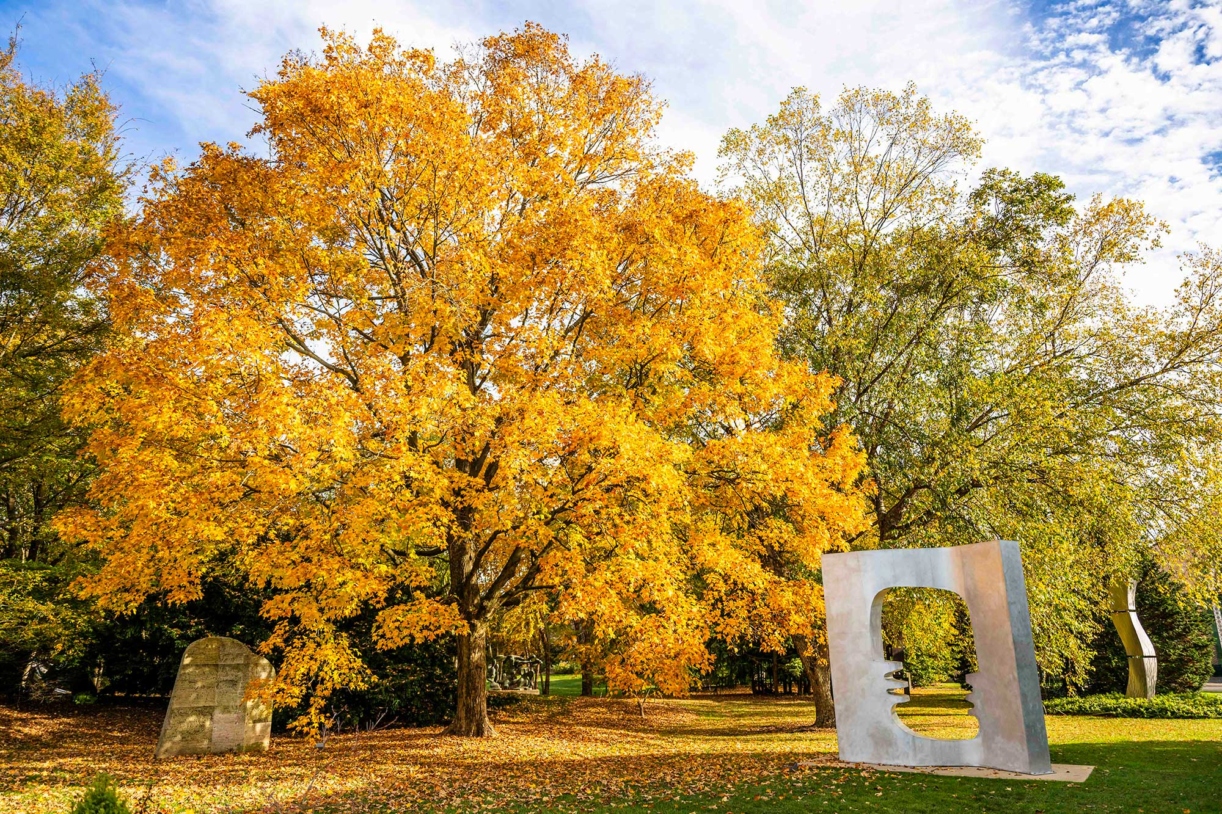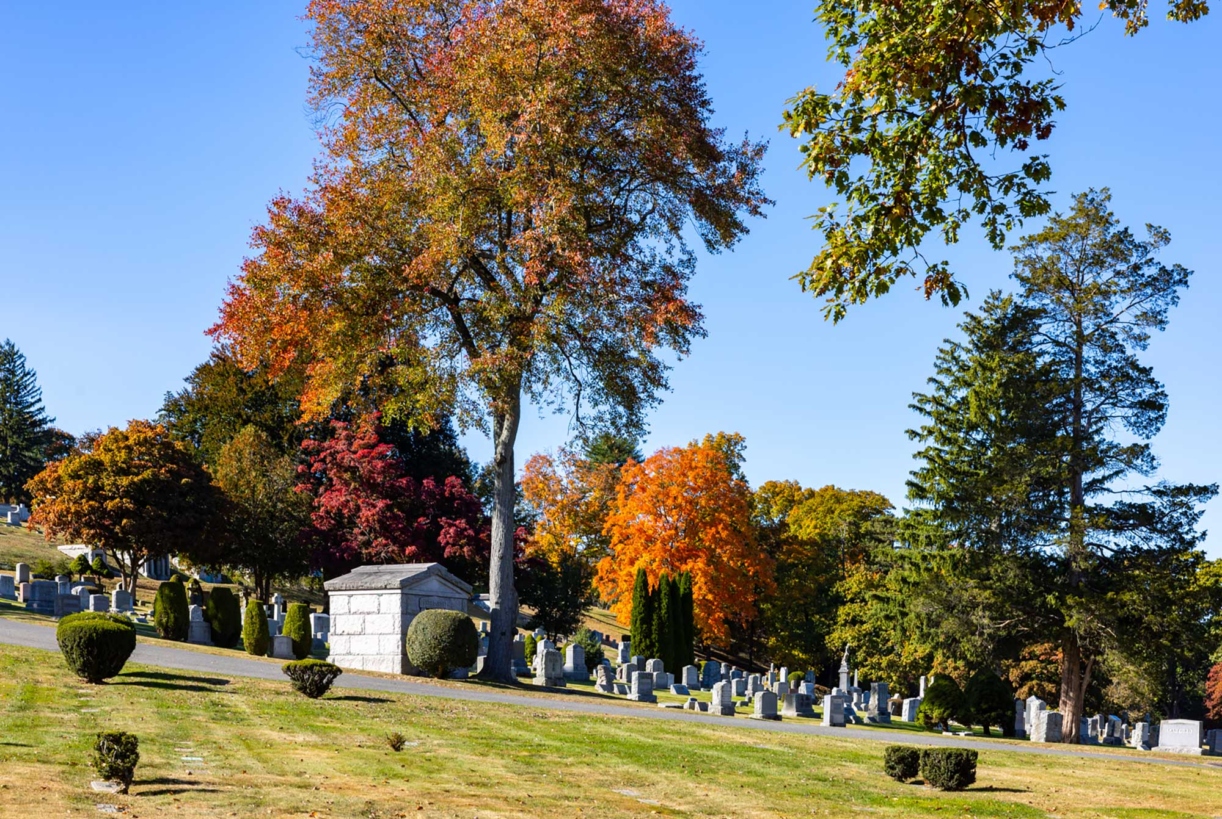ArbNet Grows and Improves Arboreta
Grounds For Sculpture near Princeton, New Jersey, is not only a year-round outdoor sculpture museum with more than 300 contemporary artworks placed in its 42 acres. It’s also an arboretum, accredited by ArbNet, the network of tree-focused institutions based at The Morton Arboretum. And that has made a difference for the sculpture park’s trees.

The process of becoming an arboretum accredited by ArbNet has helped Grounds For Sculpture, an outdoor art park in New Jersey, professionalize its tree collection.
“It’s pushed us forward,” said Janis Napoli, director of horticulture. Although Grounds For Sculpture (above) had always been intended as an arboretum and had been planted with a wide array of trees, “we had no proper records,” Napoli said. “The ArbNet accreditation process really helps professionalize your collection.”
First, the art park had to label trees—25 different kinds for Level I accreditation, which it achieved in 2022, and then 100 trees to reach Level II accreditation in 2024. Now, Grounds For Sculpture has received a state grant to create a plant database. Using examples and guidance from ArbNet, it has developed a plan for the future of its tree collection. It is participating in a horticultural research project about boxwoods. And Napoli and the park’s other staff are thinking about how they might someday achieve Level III.
Grounds For Sculpture is just one example of the way that the free ArbNet arboretum accreditation program helps a wide variety of institutions improve their tree management and make their trees a focus of their identity.
Its accreditation standards serve as a road map. The tool kits it provides for some kinds of institutions, such as schools and cemeteries, give administrators who may know little about trees a place to start. The resources it makes available, such as examples of tree collection plans, can help arboreta develop their own documents and policies. All of this is made possible by the generous support of The Morton Arboretum’s donors.
“Our goal is to encourage and help all kinds of tree-focused places and bring them together in a community of arboreta,” said Andrea Brennan, ArbNet manager. Founded by The Morton Arboretum in 2011, ArbNet is the world’s only accreditation program specifically for arboreta. The network of 848 accredited arboreta it has recognized in its nearly 15-year history includes institutions on six continents.
The result of its work is to make trees important to more places and more people. “When we tell people we’re an arboretum, their eyes light up,” said Juliana Goodlaw-Morris, co-director of sustainability and climate justice at California State University San Marcos, about 40 miles northeast of San Diego.
The campus, a former chicken farm, is just 35 years old and doesn’t have many big trees yet. But the entire grounds are a Level I arboretum, and with students’ help, an app used to navigate the campus locates and identifies its trees.
“Working to become accredited brought a lot of people on campus together,” Goodlaw-Morris said.
As its campus grows, Cal State San Marcos will need to plant many more trees, especially drought-tolerant native species. Inspired by ArbNet, it is now developing a nursery so it can grow its own. That will help save the university money, provide instructional opportunities, and possibly help it achieve a higher accreditation level.
In Ohio, the historic Oak Grove Cemetery, established in 1851 and owned by the city of Delaware, just became accredited as a Level I arboretum this year. Ohio State University Master Gardener volunteers worked through the application process and created QR codes for trees on its 600 parklike acres. The city arborist helped select the first 64 trees to label, and the public works department made signs.
“The goal was to be ready to do a ceremony on Arbor Day, and they did it,” said Amy Wright, the cemetery’s administrator.
She is already leading tree tours, planning educational events, and imagining hiking trails through a forested area. “The cemetery was created to get people outdoors—to be a park, not just a cemetery,” she said. “Being an arboretum helps encourage people to come out and enjoy it.”
Of the arboreta that ArbNet has accredited so far, about 60 percent are Level I. Only the largest and most science- and conservation-oriented institutions—places such as The Morton Arboretum, the Morris Arboretum & Gardens of the University of Pennsylvania, and the Royal Botanic Gardens in Sydney, Australia—are accredited at Level IV.
Many Level I arboreta—schools, parks, cemeteries, office parks, and other places that are not formal public gardens but are proud of their trees—may never attempt to reach a higher accreditation level. “They don’t have that capacity,” said ArbNet coordinator Sue Paist. Still, being accredited as arboreta brings public attention to their trees and helps them improve their tree care. It also plugs them into a network of tree-focused institutions and experts that can help each other. And some may be inspired to strive higher.
Just north of New York City is the 137-year-old Kensico Cemetery, designed to be a place of natural beauty. With thousands of trees on its 460 acres, it was accredited at Level I in 2022 and at Level II in 2023. As a result, “we’ve been really increasing our public programming around trees,” said Natalie Craig, the cemetery’s communications coordinator. “It’s tied to our mission.”

The 137-year-old Kensico Cemetery in Valhalla, New York, with thousands of trees on its 460 acres, is accredited as a Level II arboretum by ArbNet.
Classes on tree planting and tree care have been popular, and Michael Cook, an ISA-certified arborist who is Kensico’s vice president and superintendent of grounds, leads tree tours showcasing some trees that are 200 years old. In a special grove, a tree is now planted every Arbor Day.
“We’re brainstorming how to grow the accreditation,” Cook said. “That means thinking about where we are with our trees and where we will be in five years.”
Being an ArbNet accredited arboretum has already made the public more aware of Kensico and its trees. Craig recalled a woman who came on a tree tour in spring before the Japanese stewartia were in bloom and returned a few weeks later to see the spectacular white flowers. “We’re getting people excited about these trees,” Craig said.